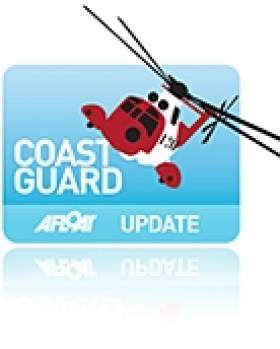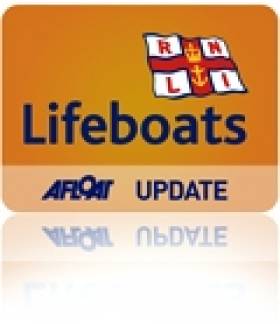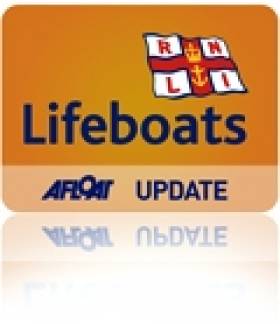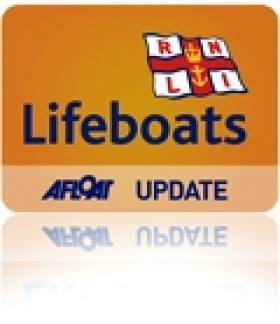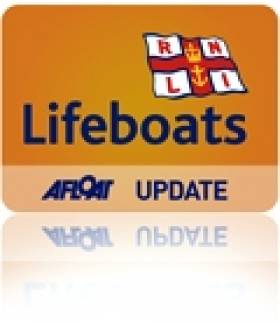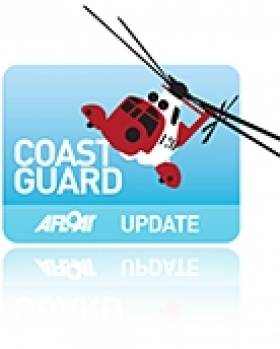Displaying items by tag: Lifeboat
Three Die in Cruiser Fire off West Cork
Three men are dead and a fourth has been injured after a boat went on fire and sank off the West Cork coast this evening. It happened in waters south of Roundcarrig Lighthouse off Adrigole Harbour, Bantry Bay. It is understood a serious fire broke out on the 25-foot cruiser. The RNLI lifeboat went to the cruiser's rescue at 5.45pm. There is no information currently about the type of cruiser involved.

Photo: courtesy of Castletownbere lifeboat
A Coast Guard helicopter spotted the men in the water. The boat was on fire and sinking as they arrived.
The bodies of the three victims have been removed to hospital. It is understood all four men, who were in their 60s, were living in the Glengarriff area.
One of the victims is Irish and the other two men are from other European countries. A fourth man, who survived the incident, has also been taken to hospital.
The boat sank a short while later off Roancarrig, about seven miles from the fishing port. Conditions were calm at the time with some light fog in the bay, the spokeswoman said. Officials from the Marine Casualty Investigation Board will carry out an inquiry into the incident.
It is understood investigations will centre on whether an explosion in the engine caused the fire.
Press Release from RNLI:
Lifeboat crew with Castletownbere RNLI responded to a callout out this evening (Monday 16 August 2010) to a 25-foot cruiser on fire seven miles off the coast of Castletownbere, off Adrigole Harbour in Bantry Bay. The Shannon based Coast Guard helicopter was on scene and recovered four casualties from the water. Three were pronounced dead and one was taken to Cork University hospital for treatment.The Castletownbere all weather lifeboat was requested to launch at 17.41 hrs in calm conditions. On arrival at the scene the lifeboat volunteers witnessed the vessel on fire and the CG helicopter was recovering the casualties from the water. The Shannon based helicopter had been out on a callout and was in the area. The lifeboat was designated on scene commander and stayed on scene until the burning cruiser sank.
Welsh Coastguards Carry Out Two Irish Sea Evacuations
A three year old boy and a commercial seaman have both been evacuated from two separate vessels due to medical problems yesterday afternoon.
Milford Haven Coastguard was contacted at just before 4.00 pm to report that a child had been taken ill onboard the roll-on-roll-off ferry Stena Europe. The vessel was 13 nautical miles west of Strumble Head. The boy was being attended to by a doctor and two nurses onboard the ferry who, after discussion with doctors at Aberdeen Royal Infirmary, advised that the boy needed to be taken off the vessel. Rescue helicopter 122 from RAF Valley was scrambled and the boy was airlifted to Withybush Hospital.
The little boy and his family were on their way home to Ireland when the child was taken ill, says Graham Warlow, Milford Haven Coastguard Watch Manager. We wish him a speedy recovery.
At the same time that the Stena Europe was in contact with Milford Haven Coastguard, the merchant vessel Marida Melissa contacted Holyhead Coastguard to report that they had their own medical emergency onboard. One of their seafarers, an Indian national, had become ill, and after discussions with doctors it was decided that the best course of action would be to evacuate him to hospital. However, the rescue helicopter was already needed for the ill child on the ferry and so Moelfre RNLI lifeboat was requested to launch with paramedics onboard.
We dont normally use lifeboats for medical evacuations but in this case, the child had to take priority, says Barry Priddis, Holyhead Coastguard Watch Manager. When the lifeboat crew arrived at the vessel, which was anchored off Moelfre, they assessed the scene and reported back to us that they were confident that they could evacuate the ill man off of the ship safely. The man was carefully lifted on to the lifeboat then taken back into Moelfre, where he was lifted into an awaiting ambulance, then on to hospital.
Lough Derg Lifeboat Assists 3 People on 'Engine Failure' Vessel
At 20.55hrs last night, Derg RNLI lifeboat was requested to launch to assist three persons on board a 43ft motor cruiser which had suffered engine failure. The lifeboat with helm Eleanor Hooker, Deirdre Kenny and Ruth Spillane on board, launched at 21.00hrs. Winds were north-westerly, Force 4, gusting 5. Visibility was initially fair with fading light. The lifeboat was alongside the casualty vessel at 21.18hrs and found all passengers to be safe and unharmed. They were requested to put on their lifejackets. The vessel had dropped anchor to prevent being pushed onto the rocky shore. Once a tow was set up, the vessel weighed anchor and was taken to the safety of the public harbour in Dromineer, where the lifeboat Deputy Launching Authority Fergal Kerney and RNLI crew members Ciaran Murphy, Ger Ahern and Dom Sharkey were waiting to take lines to assist moor the boat.
The lifeboat returned to station and was ready for service again at 23.00hrs
Related Safety posts
RNLI Lifeboats in Ireland
Safety News
Rescue News from RNLI Lifeboats in Ireland
Coast Guard News from Ireland
Water Safety News from Ireland
Marine Casualty Investigation Board News
Marine Warnings
Launch of Helensburgh Lifeboat following capsized dinghy
At 6.27pm on Wednesday 11 August 2010 Clyde Coastguard instructed the launch of Helensburgh RNLI Lifeboat after they were advised that a dinghy had capsized off the Helensburgh sea front and that there were two children in the water; the adult with them appeared to be having difficulty righting the dinghy.
While the inshore lifeboat (ILB) was proceeding to the scene, Clyde Coastguard advised that a passing RIB had taken the children ashore however the adult was still trying to right the dinghy. At 6.37pm the ILB was on scene where the crew helped to right the boat; this was complicated by the fact that the mast was stuck in the mud.Once 'unstuck', the dinghy was towed back to Helensburgh Pier by the ILB. The ILB then returned to base.
Related Safety posts
RNLI Lifeboats in Ireland
Safety News
Rescue News from RNLI Lifeboats in Ireland
Coast Guard News from Ireland
Water Safety News from Ireland
Marine Casualty Investigation Board News
Marine Warnings
County Antrim's Red Bay Lifeboat crew launched this evening (Saturday 7 August 2010) to rescue a brother and sister who had got into difficulty in the Boulder Field on Fair Head rocks on the North Antrim Coast. This is the first callout for Red Bay's new Atlantic 85 lifeboat Geoffrey Charles.
The call for help was received at 18.25 this evening when the siblings went walking in the Boulder field and got into difficulty. The Red Bay lifeboat was launched and in a heavy swell manoeuvred close to the rocks. One of the volunteer lifeboat crew then swam from the lifeboat onto the rocks with another crewmember's drysuit and a lifejacket. He then assisted the casualties one at a time using a rope.
Under difficult conditions the two casualties were recovered onto the lifeboat and landed at Ballycastle. No further medical attention was needed. Commenting on the rescue Red Bay RNLI helm Paddy McLaughlin said, " Although people like to walk in this scenic area of North Antrim it can be a very dangerous spot. This was a successful first callout for our new lifeboat and the two people are recovering well from their ordeal."
The new lifeboat was only put on station less than a fortnight ago. It has a number of improvements on its predecessor including a faster top speed of 35 knots; radar; provision for a fourth crew member and more space for survivors. It can operate safely in daylight in up to force 7 conditions and at night in up to force 6, it is also capable of being beached in an emergency.
Related Safety posts
RNLI Lifeboats in Ireland
Safety News
Rescue News from RNLI Lifeboats in Ireland
Coast Guard News from Ireland
Water Safety News from Ireland
Marine Casualty Investigation Board News
Marine Warnings
Clifden Lifeboat Calls for Vigilance over Hoax Flares
The RNLI Lifeboat in Clifden, Co. Galway has issued a plea over a series of call outs due to the irresponsible use of flares at the weekend. Flares were spotted off Roundstone which led to an extensive search mission in the area. It is the latest in a series of flare sightings in the area. Sources believe the cause of the problem may be expired flares let off from land.
Related Safety posts
RNLI Lifeboats in Ireland
Safety News
Rescue News from RNLI Lifeboats in Ireland
Coast Guard News from Ireland
Water Safety News from Ireland
Marine Casualty Investigation Board News
Marine Warnings
Baltimore Lifeboat Assists Yacht Adrift
The Baltimore RNLI inshore lifeboat Bessie, was launched this evening to assist a yacht that was adrift west of the Kedge Island near Baltimore, West Cork. The 26ft yacht with two people on board had been making its way from Glandore to Schull when its engine failed. The two crew on board decided that they would not be able to make their way to a safe harbour under sail and issued a call for assistance. Baltimore lifeboat was alerted at 19:54. Within minutes the inshore lifeboat Bessie was launched. Helm Youen Jacob with his crew, Ronan Callanan and Paul O’Driscoll, made their way towards the Kedge and having located the yacht established a tow. The casualty was towed to the safety of Baltimore Harbour. Prevailing weather conditions were moderate with Westerly winds of 12-15 knots.
Related Safety posts
RNLI Lifeboats in Ireland
Safety News
Rescue News from RNLI Lifeboats in Ireland
Coast Guard News from Ireland
Water Safety News from Ireland
Marine Casualty Investigation Board News
Marine Warnings
Busy Weekend for Baltimore Lifeboat
Baltimore Inshore lIfeboat was called into service twice on Saturday to assist vessels in distress in poor weather conditions. A yacht dragging its anchor in Church Strand called for assistance while winds were freshening to force 7 from the southwest with heavy rain and poor visibility. The alarm was raised at 20:15 on Saturday. Helmsman John Kearney and crew Micheal Cottrell and Ronan Calnan provided assistance to the lone yachtsman, helped to secure the vessel and escorted her back to Baltimore Harbour.
Later at 22:40 the inshore lifeboat was again called out to give assistance to a RIB that had gone aground on a rocky shore following engine failure. There was one man and two children on board at the time. The inshore lifeboat was launched again under the direction of Helmsman John Kearney and crew Paul O'Driscoll and Tadhg Collins. Again the lifeboat was able to secure the safety of the vessel and passengers.
Related Safety posts
RNLI Lifeboats in Ireland
Safety News
Rescue News from RNLI Lifeboats in Ireland
Coast Guard News from Ireland
Water Safety News from Ireland
Marine Casualty Investigation Board News
Marine Warnings
Coastguard Pilot Flies 500th Mission
Minister for Transport Noel Dempsey yesterday congratulated an Irish Coast Guard pilot who has just completed his 500th rescue mission, becoming one of a handful of helicopter pilots in western Europe to have done so.
On July 11, operating from the Irish Coast Guard base at Waterford, Capt Rayner and his crew attended an incident 10 nautical miles east of Waterford Airport, where multiple casualties were in difficulty in the water.
On rescuing the party, one injured male was transferred to Waterford Regional Hospital for treatment. With that operation, Capt Rayner joined an elite group of SAR crewmembers who have achieved an impressive 500 rescue missions during their careers.
Ireland’s Minister for Transport, Noel Dempsey, said: "Martyn epitomises the dedication, experience and expertise that makes the Irish Coast Guard one of the best in the world. I congratulate him on his achievement of 500 rescue missions and wish to publicly commend the valuable contribution he has made, and continues to make to SAR in Ireland."
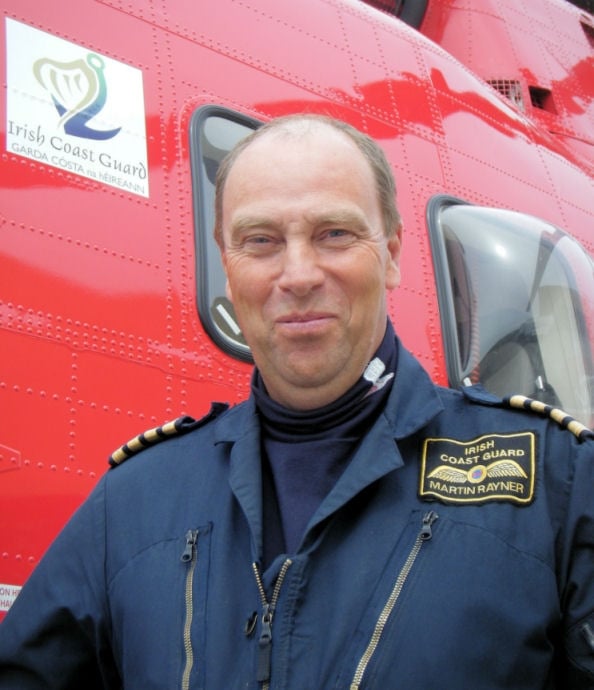
He commenced flying on the Irish Coast Guard contract in 1991 to set up the first Irish Coast Guard SAR base in Shannon Airport. Over the following 10 years Capt Rayner guided the Shannon base as chief pilot, line trainer and SAR Captain. He spent many years flying West of Shannon in all weather conditions, commanding the R115 Shannon base on missions far into the Atlantic Ocean.
“We are delighted for Martyn. This level of experience is rarely seen amongst SAR crew worldwide. We are very pleased to have the benefit of Martyn’s calibre of experience flying SAR missions around our coast,“ said Mark Kelly, managing director of CHC Ireland.
“Most SAR pilots fly an average of 20 missions per year. Martyn has been accident free for his entire career with CHC and is a shining example of our commitment to safety.”
In 2002 Capt Rayner, along with his wife Maureen, temporarily left Irish SAR for the Far East to fly offshore of Brunei. He returned to Ireland in 2005 and was welcomed with open arms to the newly established Waterford Base.
“Everyone at CHC is immensely proud of Capt Rayner’s unique achievement in reaching 500 missions. His vast experience, patience, sense of humour and knowledge of SAR is the backbone of our operation today,“ said Capt Dara Fitzpatrick, chief pilot, CHC Waterford Base.
CHC Ireland is an affiliate of CHC Helicopter through its ownership interest in EEA Helicopter Operations B.V. CHC Helicopter is the world’s largest offshore helicopter operator and provides civilian search and rescue services in Ireland, the UK, Denmark and Australia. Earlier this month another CHC SAR crew was recognized with a “Best of Irish” award for their role in successfully recovering the pilot of a light aircraft that crashed in the Irish Sea.
Warning Issued Over Inflatable Toys Being Swept Out to Sea
Coastguard Sector Manager George Crumpler says,
"Inflatable boats and toys can be great fun, but we'd rather that you used them in swimming pools than at the beach. If you do use one at the beach, tether it to an adult and never use it in an offshore wind. Inflatables can easily be blown out to sea and, overturn.
Make sure that children are properly supervised. We deal with lost children every year and it can be distressing for children and adults alike. Try to go to a lifeguarded beach if you can and stay within the flagged area.
"Remember to check the weather and the tide times (these can often be found at the entrance to the beach) so that the tide doesn't take you by surprise or cut you off.
"If you see anyone in difficulty, tell the lifeguard if one is available or call the Coastguard on 999.
Remember to have a great time and return home safely."
If you want to prepare for your day out on the coast, you might like to visit Directgov for Kids where there are games and activities for children. Visit http://kids.direct.gov.uk/ and click on the world, then go to the 'watch station' in the 'places' icon.



























